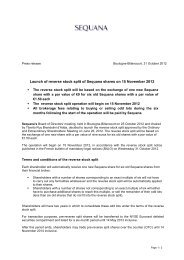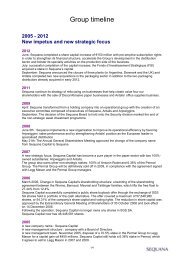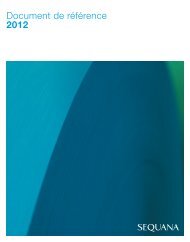Contents
Registration document PDF - Sequana
Registration document PDF - Sequana
Create successful ePaper yourself
Turn your PDF publications into a flip-book with our unique Google optimized e-Paper software.
Financial position – resultsNotes to the consolidated financial statements 4Changes in fair value are recorded in profit or loss under eitherfinancial income or expenses, or current operating income andexpenses, depending on the type of instrument, except for thefollowing instruments that qualify for hedge accounting underIFRS:■■cash flow hedges: changes in the fair value of the effective portionof a derivative that is designated and qualifies as a cashflow hedge are recognised directly in equity. Amounts accumulatedin equity are recycled to the income statement duringthe period in which the hedged item affects profit (for example,when a planned sale actually takes place) or when the Groupno longer expects the hedged forecast transaction to occur.The gain or loss relating to the ineffective portion of the hedgeis recognised in the income statement in financial income orexpenses. When the forecast transaction that is hedged resultsin the recognition of a non-financial asset or liability, the cumulativefair value adjustments on the hedging instrument thatwere previously deferred in equity are transferred from equityand included in the initial measurement of the cost of the assetor liability concerned;■■fair value hedges: changes in the fair value of derivatives thatare designated and qualify as fair value hedges are recorded inprofit or loss under the same caption as any changes in the fairvalue of the hedged asset or liability that are attributable to thehedged risk;■■hedges of net investments in foreign operations: any fair valuegains or losses on the hedging instrument relating to the effectiveportion of the hedge are recognised in equity. The gain orloss relating to the ineffective portion is recognised immediatelyin profit or loss. When the foreign operation is divested,gains and losses accumulated in equity are transferred to theincome statement under the same caption as the disposal gainor loss.B15 - Assets held for sale and liabilities related to assetsheld for saleWhen the Group expects to recover the cost of an asset throughits sale rather than through use, and when a sale is deemed highlyprobable, the asset is classified as held for sale and is measuredat the lower of its carrying amount and fair value less costs tosell. Assets classified as held for sale are not depreciated but animpairment loss is recognised if their carrying amount is higherthan fair value less costs to sell. The impairment loss is reversed ifthere is a subsequent increase in fair value less costs to sell.If the sale involves more than one identifiable asset and insteadinvolves a Group of related assets and liabilities which the Groupintends to dispose of in a single transaction, this disposal group isclassified as being held for sale on a separate line in the statementof financial position – no offsetting is allowed between assets heldfor sale and the related liabilities – and is measured at the lower ofits carrying amount and fair value less costs to sell.B16 - Provisions for pension and other employee benefitobligationsSequana and its subsidiaries provide their employees with differenttypes of supplementary employee benefit plans. The specificcharacteristics of these plans vary depending on the laws, regulationsand practices applicable in each of the countries where theGroup’s employees work.The plans that have been set up are either defined contributionplans or defined benefit plans.A defined contribution plan is a pension plan under which theGroup pays fixed contributions to a separate organisation whichfrees the employer from all future legal or constructive obligationsin the event that plan assets are not sufficient to cover theamounts due to the employees. Therefore, apart from the expenserelating to the contributions paid to such organisations, no otherrelated liability is carried in the Group’s books.Defined benefit plans are all post-employment benefit plansother than defined contribution plans. The Group has an obligationto set aside provisions for the future benefits due to its activeemployees and to pay the benefits of its retired employees. Theactuarial risk and investment risk relating to these plans are bornein substance by the Group.Pension and other post-employment benefit obligations aremeasured in accordance with the projected unit credit method.The amount of the related provision is calculated on an individualbasis using assumptions in terms of life expectancy, employeeturnover, increases in salaries, increases in annuities, increases inmedical costs and discounting of future sums payable. The specificassumptions for each plan take account of the local economicand demographic circumstances.According to IAS 19, the rate used to discount employee benefitobligations should be determined by reference to market yieldson corporate bonds issued in the monetary zone in question, withmaturities similar to the corresponding obligations, and rated“high quality” by the established rating agencies.Sequana uses the Markit iBoxx indices for the euro and sterlingzones and the Citigroup indices for the dollar zone. These indicesare calculated daily for quite a comprehensive range of bondmaturities and ratings, and each bond in the index basket complieswith specific rating, maturity and liquidity criteria.All bonds in the basket are equally price-weighted in returns.Markit and Citigroup update all of the bonds in the index basketsevery month based on any changes to residual maturities orto credit ratings.Defined benefit plans are sometimes funded by external planassets. The liability recognised in respect of defined benefit pensionsand other long-term benefits is the present value of the projectedbenefit obligation at the end of the reporting period lessthe fair value of plan assets and minus any past-service cost notyet recognised (except for other long-term benefits for which thepast service cost is recognised directly in profit or loss). If theresult of this calculation is a net commitment, this is recognisedas a liability. If the calculated amount is a surplus, the amount ofthe recognised asset is capped in line with the guidance providedunder IFRIC 14 in respect of the limits on defined benefit assets.Sequana | 2012 Document de référence (English version) | 105









